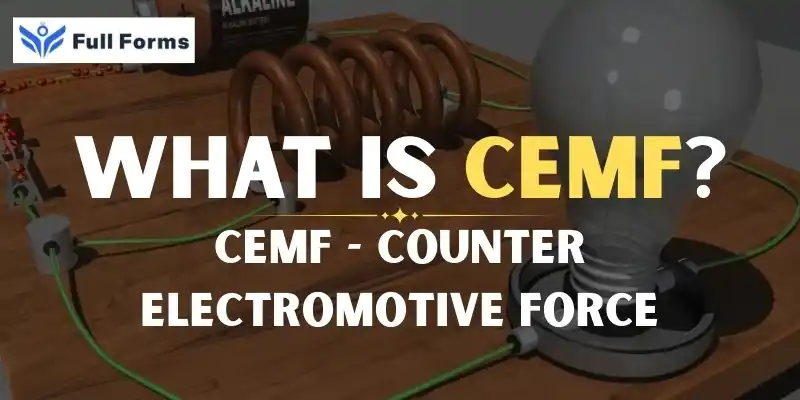Counter Electromotive Force
(CEMF)

Description
Understanding Counter Electromotive Force: A Basic Overview
Electricity powers most of the things that we use every day, such as fans, washing machines, electric cars, and even machines used in factories. But have you ever thought about what’s going on in an electric motor when it runs? One big idea that helps to understand electric motors is known as Counter Electromotive Force – often just Counter EMF or CEMF.
What is Counter Electromotive Force?
Consider an electric motor that is running and turning. There arises a certain voltage between two points. The important point to understand is that this voltage runs opposed to the direction of the voltage that is applied in order to make the motor run and hence termed “counter” EMF.
Using electricity to spin a motor, that motor’s spinning action creates another voltage that opposes the original voltage. A little like giving a push to a swing—while you are trying to move it forward, it pushes back against your hand.
Why Does the Counter Electromotive Force Occur?
To get a better grasp of CEMF, let’s turn to some fundamentals of electricity and magnetism:
- When you apply voltage to an electric motor, current will flow through wires wound on an iron core.
- Placing these wires inside a magnetic field will cause the motor to rotate since force acts between the magnetism and electricity.
- When the motor spins, the wires cut through the magnetic field.
This ‘cutting’ or ‘slicing’ will also cut through a few laws of physics, more commonly known as Faraday’s Law of Electromagnetic Induction:
- ‘Cutting’ through lines of magnetic force induces voltage in the wire.
- This new voltage is with respect to the voltage with which you supplied the motor in the first place.
So, the instant the motor begins to spin, it starts ‘fighting back’ by producing this counter-voltage.
Why Counter EMF is Important?
Counter EMF is not just some theoretical concept; it is a practical one. The reason for this is:
- It controls motor speed – When a motor spins faster, counter EMF naturally increases, thus limiting the speed of the motor. If one tries to make the motor go faster, counter EMF pushes back harder.
- The motor’s life is safeguarded – When you first turn a motor on, it is not spinning yet, so there is no counter EMF. So a very high current can flow, which would be hazardous if the motor were not intended for that. As it gains speed, the counter EMF increases, with current automatically falling to safe levels.
- Counter EMF and Efficiency – Counter EMF helps the motor draw only that much electricity which is appropriate to the load it is carrying. As the load increases (e.g., if a mixer is grinding tougher), then the motor slows down, counter EMF drops, and more current flows to provide that extra power.
Where Do We Find Use of Counter EMF in Everyday Life?
- Fans and Pumps – When you close a switch to start a fan, it takes a while to come up to full speed. At that moment, more current is allowed to pass. Once it attains full speed, back EMF opposes, and thus the current decreases.
- Electric Cars – Back EMF is responsible for the management of the speed and increased efficiency of motors in cars.
- Household Appliances – Washing machines, mixers, and grinders all have motors running inside producing a back EMF.
Explained in Simple Words
Think of counter EMF as a bicycle coasting down a hill. When you pedal initially, it is easy, but as you pick up speed, the wind is going to push against you very hard. In the same way, as the motor spins faster, the more counter EMF ‘pushes back,’ the harder it becomes for more electricity to flow in.
What If Load Changes?
Should the fan begin sticking — that is, when the motor is subjected to more loads — the motor will slow down. Counter EMF will go down, more current will feed into the motor so that it tries to come back up again, coping with the load. This self-correcting property makes motors very workable and dependable.
Summary of Concept
- The counter electromotive force is:
- the voltage that a motor in operation creates, opposing the applied voltage.
- induced by a magnetic field cut through by the motor’s revolving coils.
- imposes a restriction on the increasing current to the motor with increasing speed.
- safeguards the motor from over-drawing of current.
- adapts to changes in load.
- increases efficiency.
Conclusion
Counter Electromotive Force (CEMF) might sound fancy and rather technical but in real sense it is just an idea by which our motors are kept safe, efficient, and under control. It’s a byproduct of how electricity and magnetism interact within a motor.
So the next time you turn on a fan or see an electric automobile, you also understand that behind the scenes several things work out in a smooth running manner – and one of them is counter EMF.
